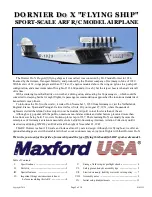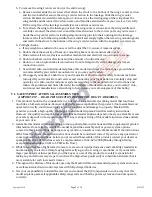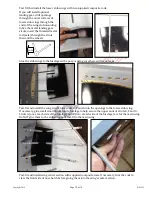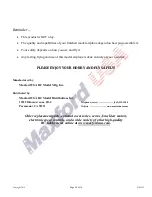
Copyright 2016
Page
5
of 14
S161222
5.
To remove the wing’s center section (or the entire wing):
a.
Remove and set aside the six screws that attach the struts to the bottom of the wing’s center section
and the two bolts that secure the wing’s center section to the fuselage. Slide the wing’s center
section backward, toward the tail, approx. 3-inches, raise the trailing edge of the wing above the
wing saddle and disconnect the aileron servo and throttle extensions from your receiver. Carefully
lift the wing free of the fuselage and safely secure all removed screws.
b.
To reattach the wing to the fuselage, position the wing center section above the wing saddle and
carefully reconnect the aileron servo and throttle extensions to the correct ports on your receiver.
Guide the wing center section’s leading-edge mounting pins into their openings in the fuselage
former at the front of the wing saddle, then reinstall and snugly tighten the two wing mounting bolts
and reattach the struts to the bottom of the wing’s center section with the supplied wood screws.
6.
Preflight checks:
a.
If any weight was added in the nose or tail to adjust the CG, ensure it remains secure.
b.
Double check the security of the motor-mounting boxes, motors and nacelle covers.
c.
Make certain all screws, clevises and other mechanical and electrical connections are secure.
d.
Double-check all control directions and the amounts of control throws.
e.
Double- or even triple-check all connections. Do not attempt to fly with a damaged or frayed
connection or wire.
f.
As with all radio-controlled model airplanes, this model must pass the radio range ground check
recommended by your radio’s manufacturer or you may not fly safely.
g.
We suggest you make it a habit to set your transmitter’s throttle control safely to minimum before
turning ON your transmitter and receiver and connecting your flight batteries. Carefully setup and
operate your radio-control and power systems according to the manufacturer’s instructions and
follow the guidelines and hints offered by the Academy of Model Aeronautics, your local R/C club,
and concerned manufacturers, all wishing to help ensure your safe enjoyment of this hobby.
VI. SAFETY PRECAUTIONS & ASSEMBLY TIPS
(
IMPORTANT – READ THIS SECTION BEFORE YOU BEGIN ASSEMBLY
)
1.
This product should not be considered a toy, but rather a sophisticated, working model that functions
much like a full-scale airplane. Because of its performance capabilities, this product, if not assembled and
operated correctly, could cause injury to you or spectators and damage to property. Maxford USA
provides you with a high-quality, thoroughly tested model airplane kit with assembly instructions.
However, the quality and capabilities of your finished model airplane depend on how you assemble it, and
your safety depends on how you use and fly it. Any testing or flying of this model airplane is done entirely
at your own risk.
2.
Assemble this model airplane according to the supplied photo instructions and this supplemental printed
information. Do not alter or modify the model beyond the assembly and/or power-system options
covered in these instructions, as doing so may result in an unsafe or unworkable model. If the instructions
differ from the photos, the written instructions should be considered correct. If you have any question or
concern about the instructions, before you proceed with assembly of this product, contact your dealer or
speak to a Maxford USA customer service representative at 562-529-3988 (Monday through Friday,
except national holidays, 9 AM to 5 PM Pacific Time).
3.
While this kit has been flight-tested to meet or exceed our rigid performance and reliability standards in
normal use, if you elect to attempt any high-stress flying, such as racing or aerobatics, or if you install a
larger power system than specified, you (the buyer or user of this product) are solely responsible for
taking any and all necessary steps to reinforce the high-stress points and/or substitute hardware that is
more suitable for such increased stresses.
4.
Throughout the lifetime of this model, use only the Maxford USA-recommended power system and a new
or well-maintained radio-control system with fully-charged batteries.
5.
It is your responsibility to install the receiver and connect the R/C components in such a way that this
model airplane passes all applicable safety/range tests and that the power system and controls operate
correctly.
































